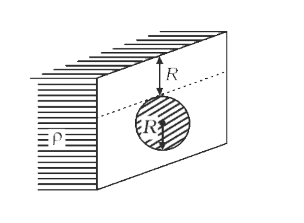The density of the atmosphere at sea level is 1.29kg/m3. Assume that it does not change with altitude. Then how high would the atmosphere extend ? g=9.8ms−2. Atmospheric pressure =1.013×105Pa.
To find how high the atmosphere would extend, we can use the relationship between pressure, density, gravitational acceleration, and height. The formula we will use is:
P=ρgh
Where:
- P is the atmospheric pressure (in Pascals),
- ρ is the density of the atmosphere (in kg/m³),
- g is the acceleration due to gravity (in m/s²),
- h is the height of the atmosphere (in meters).
1. Identify the given values:
- Atmospheric pressure, P=1.013×105Pa
- Density of the atmosphere, ρ=1.29kg/m3
- Acceleration due to gravity, g=9.8m/s2
2. Rearrange the formula to solve for height h:
h=Pρg
3. Substitute the known values into the equation:
h=1.013×105Pa1.29kg/m3×9.8m/s2
4. Calculate the denominator:
Denominator=1.29×9.8=12.622kg/(m2s2)
5. Now, calculate h:
h=1.013×10512.622≈8026.5m
6. Convert meters to kilometers:
h≈8.0265km≈8.03km
Final Answer:
The atmosphere would extend approximately 8.03 kilometers above sea level.
- P is the atmospheric pressure (in Pascals),
- ρ is the density of the atmosphere (in kg/m³),
- g is the acceleration due to gravity (in m/s²),
- h is the height of the atmosphere (in meters).
- Atmospheric pressure, P=1.013×105Pa
- Density of the atmosphere, ρ=1.29kg/m3
- Acceleration due to gravity, g=9.8m/s2
h=Pρg
h=1.013×105Pa1.29kg/m3×9.8m/s2
Denominator=1.29×9.8=12.622kg/(m2s2)
h=1.013×10512.622≈8026.5m
h≈8.0265km≈8.03km
The atmosphere would extend approximately 8.03 kilometers above sea level.
Topper's Solved these Questions
- MECHANICAL PROPERTIES OF FLUIDSBOOK - NCERT ENGLISHCHAPTER - MECHANICAL PROPERTIES OF FLUIDSEXERCISE - EXERCISE
31 Videos
- LAWS OF MOTION BOOK - NCERT ENGLISHCHAPTER - LAWS OF MOTION EXERCISE - EXERCISE
40 Videos
- MECHANICAL PROPERTIES OF SOLIDSBOOK - NCERT ENGLISHCHAPTER - MECHANICAL PROPERTIES OF SOLIDSEXERCISE - EXERCISE
21 Videos
Similar Questions
The density of the atmosphere at sea level is 1.29kg/m3. Assume that it does not change with altitude, how high should the atmosphere extend?
View SolutionWhat is the pressure on a swimmer 10m below the surface of lake? g=10ms−2, atmospheric pressure = 1.01×105Pa
View SolutionWhat is the pressure in an ocean at a depth of 1000 m, if the density of water is 1.024×103kgm3. Atmospheric pressure P.=1.01×105 Pa.
View SolutionIf the density of a gas at the sea level at 0∘C is 1.29kgm−3, what is its molar mass? (Assume that pressure is equal to 1bar.)
View SolutionThe lower end of a capillary tube of diameter 2.0 mm is dipped 8.00cm below the surface of water in a beaker. What is the pressure required in the tube in order to blow a hemispherical bubble at its end in water? The surface tension of water at temperature of the experiments is 7.30×10−2Nm−1. 1 atmospheric pressure =1.01×105Pa, density of water =1000kg/m3,g=9.80ms−2. also calculate the excess pressure.
View SolutionAt a depth of 500m in an ocean (a) what is the absolute pressure? (b) What is the gauge pressure? Density of sea water is 1.03×103kg/m3,g=10ms−2. Atmospheric pressure = 1.01×105Pa.
View SolutionAt a depth of 1000 m in an ocean (a) what is the absolute pressure? (b) what is the gauge pressure? (c ) Find the force acting on the window of area 20cm×20cm of a submarine at this depth, the interior of which is maintained at sea-level atmospheric pressure. The density of sea water is 1.03×103kgm−3, g=10ms−2. Atmospheric pressure = 1.01×105Pa.
View SolutionWhat is the absolute pressure on a swimmer 10m below the surface of a lake? Take atmospheric pressure 1×105N/m2
View SolutionFind the hydrostatic force (in kN) acting on the circular patch of radius R.(R=1m,g=10m/s2 , atmospheric pressure = 10 ^(5 ) Pa )

View SolutionAssuming that the atmosphere has the same density anywhere as at sea level (ρ=1.3kgm−3) and g to be constant (g=10ms−2). What should be the approximate height of atmosphere ?
(ρ0=1.01×105Nm−2)
View Solution
